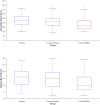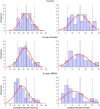Verbal Memory Impairment in Polydrug Ecstasy Users: A Clinical Perspective
- PMID: 26907605
- PMCID: PMC4764468
- DOI: 10.1371/journal.pone.0149438
Verbal Memory Impairment in Polydrug Ecstasy Users: A Clinical Perspective
Abstract
Background: Ecstasy use has been associated with short-term and long-term memory deficits on a standard Word Learning Task (WLT). The clinical relevance of this has been debated and is currently unknown. The present study aimed at evaluating the clinical relevance of verbal memory impairment in Ecstasy users. To that end, clinical memory impairment was defined as decrement in memory performance that exceeded the cut-off value of 1.5 times the standard deviation of the average score in the healthy control sample. The primary question was whether being an Ecstasy user (E-user) was predictive of having clinically deficient memory performance compared to a healthy control group.
Methods: WLT data were pooled from four experimental MDMA studies that compared memory performance during placebo and MDMA intoxication. Control data were taken from healthy volunteers with no drug use history who completed the WLT as part of a placebo-controlled clinical trial. This resulted in a sample size of 65 E-users and 65 age- and gender-matched healthy drug-naïve controls. All participants were recruited by similar means and were tested at the same testing facilities using identical standard operating procedures. Data were analyzed using linear mixed-effects models, Bayes factor, and logistic regressions.
Results: Findings were that verbal memory performance of placebo-treated E-users did not differ from that of controls, and there was substantial evidence in favor of the null hypothesis. History of use was not predictive of memory impairment. During MDMA intoxication of E-users, verbal memory was impaired.
Conclusion: The combination of the acute and long-term findings demonstrates that, while clinically relevant memory impairment is present during intoxication, it is absent during abstinence. This suggests that use of Ecstasy/MDMA does not lead to clinically deficient memory performance in the long term. Additionally, it has to be investigated whether the current findings apply to more complex cognitive measures in diverse 'user categories' using a combination of genetics, imaging techniques and neuropsychological assessments.
Conflict of interest statement
Figures


Similar articles
-
Peripheral endocannabinoid concentrations are not associated with verbal memory impairment during MDMA intoxication.Psychopharmacology (Berl). 2018 Mar;235(3):709-717. doi: 10.1007/s00213-017-4787-2. Epub 2017 Nov 16. Psychopharmacology (Berl). 2018. PMID: 29143869 Free PMC article. Clinical Trial.
-
Long-term neuropsychological effects of ecstasy in middle-aged ecstasy/polydrug users.Psychopharmacology (Berl). 2010 Jan;207(4):583-91. doi: 10.1007/s00213-009-1688-z. Epub 2009 Oct 13. Psychopharmacology (Berl). 2010. PMID: 19823808
-
Depression, impulsiveness, sleep, and memory in past and present polydrug users of 3,4-methylenedioxymethamphetamine (MDMA, ecstasy).Psychopharmacology (Berl). 2014 Feb;231(4):737-51. doi: 10.1007/s00213-013-3288-1. Epub 2013 Oct 11. Psychopharmacology (Berl). 2014. PMID: 24114426
-
Mood, cognition and serotonin transporter availability in current and former ecstasy (MDMA) users: the longitudinal perspective.J Psychopharmacol. 2006 Mar;20(2):211-25. doi: 10.1177/0269881106059486. J Psychopharmacol. 2006. PMID: 16510479 Review.
-
Executive working memory deficits in abstinent ecstasy/MDMA users: a critical review.Neuropsychobiology. 2009;60(3-4):159-75. doi: 10.1159/000253552. Epub 2009 Nov 5. Neuropsychobiology. 2009. PMID: 19893333 Review.
Cited by
-
Cognitive Effects of MDMA in Laboratory Animals: A Systematic Review Focusing on Dose.Pharmacol Rev. 2019 Jul;71(3):413-449. doi: 10.1124/pr.118.017087. Pharmacol Rev. 2019. PMID: 31249067 Free PMC article.
-
Understanding the Mechanisms of Action and Effects of Drugs of Abuse.Molecules. 2023 Jun 24;28(13):4969. doi: 10.3390/molecules28134969. Molecules. 2023. PMID: 37446631 Free PMC article. Review.
-
How Postmortem Redistribution of MDMA in Acute Alcohol-MDMA Combined-Use Rats Change under Effects of Alcohol.Sci Rep. 2017 Jun 22;7(1):4038. doi: 10.1038/s41598-017-04416-y. Sci Rep. 2017. PMID: 28642585 Free PMC article.
-
Dark Classics in Chemical Neuroscience: 3,4-Methylenedioxymethamphetamine.ACS Chem Neurosci. 2018 Oct 17;9(10):2408-2427. doi: 10.1021/acschemneuro.8b00155. Epub 2018 Jul 12. ACS Chem Neurosci. 2018. PMID: 30001118 Free PMC article. Review.
-
Depressive mood ratings are reduced by MDMA in female polydrug ecstasy users homozygous for the l-allele of the serotonin transporter.Sci Rep. 2018 Jan 18;8(1):1061. doi: 10.1038/s41598-018-19618-1. Sci Rep. 2018. PMID: 29348651 Free PMC article.
References
-
- EMCDDA. European drug report 2015. European Monitoring Centre for Drugs and Drug Addiction, 2015. - PubMed
-
- DIMS. DIMS Jaarbericht 2009. Netherlands Institute of Mental Health and Addiction, 2009.
-
- DIMS. Jaarbericht 2014. Netherlands Institute of Mental Health and Addiction, 2014.
-
- EMCDDA. European drug report. European Monitoring Centre for Drugs and Drug Addiction, 2014. - PubMed
Publication types
MeSH terms
Substances
LinkOut - more resources
Full Text Sources
Other Literature Sources
Medical

